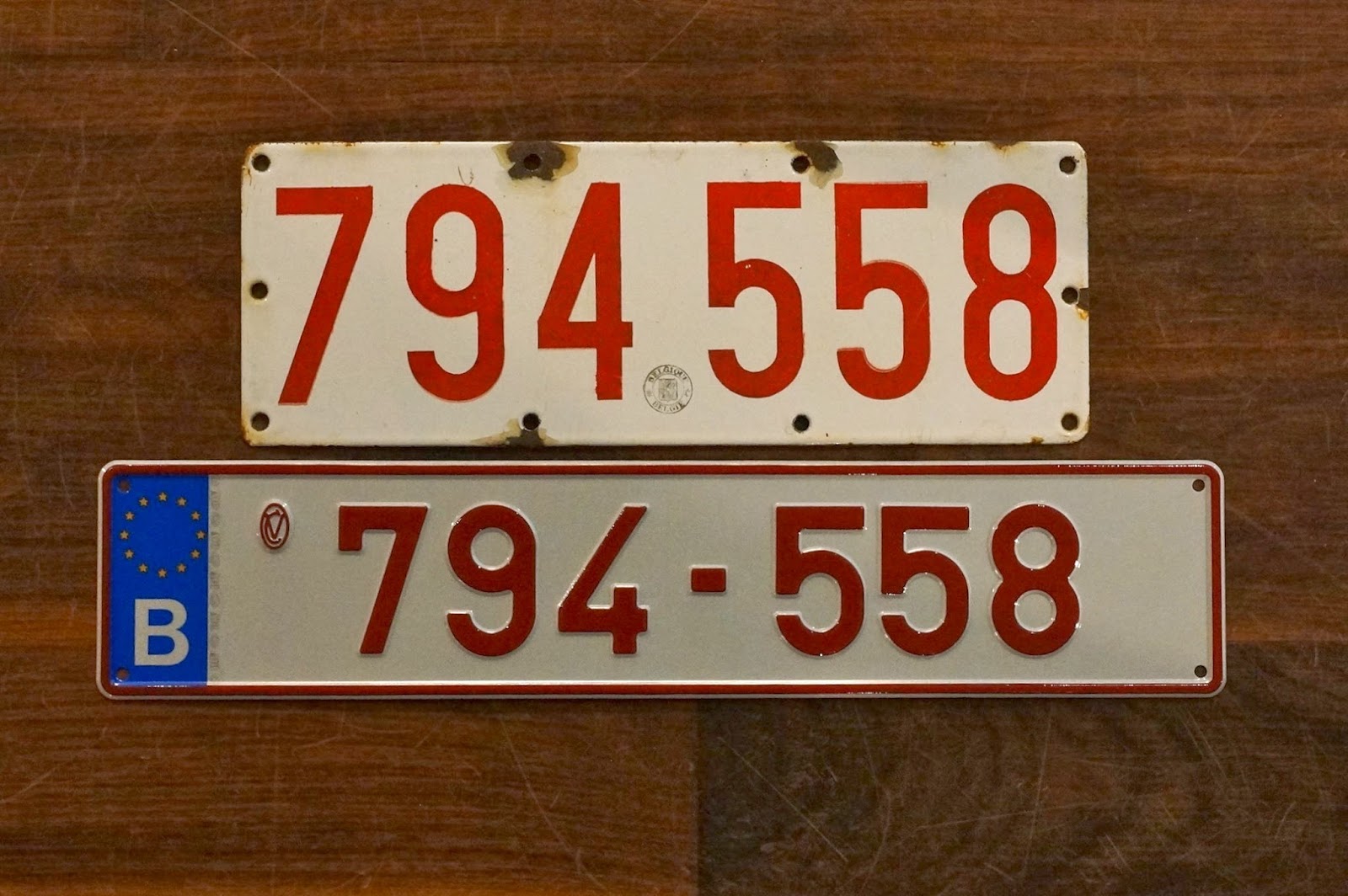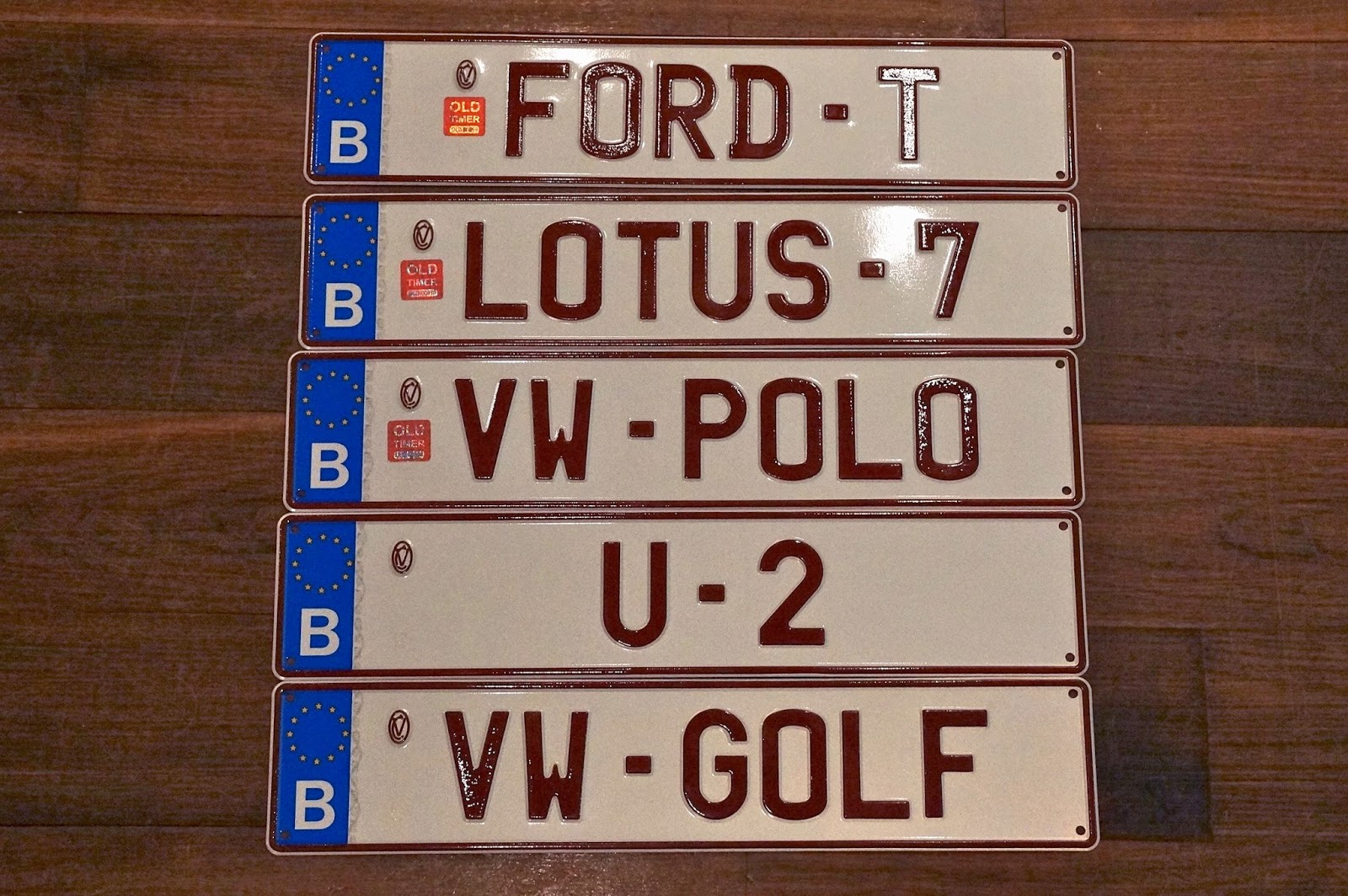Summary:
- 31 March 2014: vanity plates (see other entry) and scooter plates (S)
- 30 June 2014: motorcycles (M), oldtimers (O), trailers (Q), taxis (T-X) and rental cars with chauffeur (T-L) EDIT (July 2014): the introduction of these plates has been postponed to October 2014 (at least) because the DIV could not meet the deadline
- 1 October 2014: professional plates (checkups [Y*] and demonstrations [Z*])
- 31 October 2014 (provisional date): temporary [W*] and export plates [X*]
- T.B.D.: national temporary plates [N*]
1. Scooters
On 31 March 2014, scooter plates will be introduced. Belgium was the last country in Europe where scooters did not have any registration, which sometimes caused problems when people drove to other countries on their scooters. The new scooter plates will not only solve this issue, but also make scooter owners identifiable (e.g. in the event of an accident or speeding).
A distinction is made between A-class scooters (speed limit: 25 km/h) and B-class scooters (speed limit: 45 km/h).
- A-class scooters will get combinations ranging from S-AAA-001 to S-AZZ-999 (and S-CAA-001 to S-CZZ-999 if necessary)
- B-class scooters will get combinations ranging from S-BAA-001 to S-BZZ-999
(and S-DAA-001 to S-DZZ-999 if necessary) - Micro cars with bodywork (e.g. Aixams, Ligiers, G-Whizzes) will get combinations ranging from S-UAA-001 to S-UZZ-999 [U stands for 'unusual'; such vehicles fall under the S index letter because they are legally considered as scooters]
Plates for oldtimer scooters (i.e. aged 25 or more), taxis and diplomats will follow later (see also below):
- O-SAX-111: A-class scooters
- O-SBX-111: B-class scooters
- O-SUX-111: micro cars with bodywork
- T-XSA-111: A-class scooters used as taxis
- T-XSB-111: B-class scooters used as taxis
- T-XSU-111: micro cars with bodywork used as taxis (+ T-XSY and T-XSZ for the small format)
- CD-SA-111: A-class scooters used by diplomats (+ CD-SC-111)
- CD-SB-111: B-class scooters used by diplomats (+ CD-SD-111)
- CD-SU-111: micro cars with bodywork used by diplomats (+ CD-SV-111 and CD-SY or SZ for the small format)
2. Motorcycles
3. Oldtimers
As of
A few subcategories will be created (X and 1 stand for any letter and digit, respectively):
- O-AXX-111: ordinary oldtimers (624,375 combinations)
- O-MXX-111: motorcycles (624,375 combinations)
- O-QXX-111: trailers (624,375 combinations)
- O-SXX-111: scooters
- O-SAX-111: A-class scooters (24,975 combinations)
- O-SBX-111: B-class scooters (24,975 combinations)
- O-SUX-111: micro cars with bodywork (24,975 combinations)
4. Trailers
Trailers, too, will be issued a new type of registration, just like the aforementioned categories, as of
5. Taxis
Another type of plates will be adapted on
A few series are reserved for scooters used as taxis:
- T-XSA-111: A-class scooters (999 combinations; if necessary: T-111-XSA)
- T-XSB-111: B-class scooters (999 combinations; if necessary: T-111-XSB)
- T-XSU-111: micro cars with bodywork (+ T-XSY and T-XSZ for the small format)
6. Rental cars with chauffeur
A last category will undergo a change
7. Professional plates: technical checkup
Since 1997, dealers have had the possibility to apply for so-called 'road tests plates' (plates with a registration starting with ZZ*, ZZ* or 1-ZZ*) in order to check whether their vehicles were technically able to drive on the road. Unfortunately, unscrupulous dealers decided to rent these plates to people who wanted to go to official technical check facilities (e.g. for homologation) but had no regular plates to do so. It has therefore been decided to put an end to such practices by both clarifying the legislation and limiting the cases in which such technical checkup plates can be used.
Use:
- only by professionals in the automotive sector (i.e. dealers and their staff)
- test drives after an upkeep, repairs, or for running in a new vehicle
- rides from dealership to the customs
- rides to and from official technical checkup facilities
- rides to a customer's residence to deliver the vehicle to them
- note that the vehicle equipped with a Y license plate does not have to belong to the owner of the Y plate, unlike the Z license plate [see below])
The new registration will start with the index letter Y, followed by another letter indicating the vehicle category, then the last two digits of the year of validity, and finally three serial letters.
By embossing the year directly onto the plate instead of using stickers, it will be easier to detect whether a plate is valid or not. Besides, since these plates will be renewed each year, it will ensure that those commercial plates remain in a decent state (many dealers do not hesitate to drill extra holes in the plates or bend them, which causes them to look ugly).
The following subcategories will be created (X and 1 stand for any letter and digit, respectively):
- YA-11-XXX: cars, vans, trucks
- YE-11-XXX: equipment companies (i.e. those creating security equipment for motor vehicles)
- YM-11-XXX: motorcycles
- YO-11-XXX: museums
- YP-11-XXX: police
- YQ-11-XXX: trailers
- YR-11-XXX: research (i.e. universities and university colleges developing cars or motors)
- YS-11-XXX: scooters
- YT-11-XXX: customs agencies
- YY-11-XXX: SHAPE and NATO (these organizations appear to import a lot of vehicles and they need such a plate to drive these cars from a harbour to the customs)
8. Professional plates: commercial test drives
The uses of the 'ordinary' dealer plates will be redefined as of 1 October 2014 to avoid fraud. The new Z plate (superseding the previous Z**, Z** and 1-Z** plates) is destined to be used by automotive dealers and sellers for the following purposes:
- regular use of a new or used vehicle by the dealer or members of staff
- this vehicle must be the property of the dealer and must have been checked by competent authorities (at official technical checkup facilities)
- commercial test drive with potential customers, on the basis of a signed agreement between the dealer and the potential customers
- loan of a new or used vehicle as a replacement for someone whose vehicle is being checked or upkept at the dealer's, for a maximum duration of 7 days
- the Z plate cannot be used to go to official technical checkup facilities)
- the Z plate cannot be used by vehicles taking part in racing events
By embossing the year directly onto the plate instead of using stickers, it will be easier to detect whether a plate is valid or not. Besides, since these plates will be renewed each year, it will ensure that those commercial plates remain in a decent state (many dealers do not hesitate to drill extra holes in the plates or bend them, which causes them to look ugly).
The following subcategories will be created (X and 1 stand for any letter and digit, respectively):
- ZA-11-XXX: cars, vans, trucks
- ZA-11-AAA to VZZ: rectangular format (13,750 combinations)
- ZA-11-WAA to XZZ: square format (1,250 combinations)
- ZA-11-YAA to ZZZ: small format (1,250 combinations)
- ZM-11-XXX: motorcycles (small format only; 15,625 combinations)
- ZQ-11-XXX: trailers
- ZQ-11-AAA to XZZ: rectangular format (15,000 combinations)
- ZQ-11-YAA to YZZ: square format (625 combinations)
- ZQ-11-ZAA to ZZZ: small format (625 combinations)
- ZS-11-XXX: scooters
- ZS-11-AAA to VZZ: rectangular format (13,750 combinations)
- ZS-11-WAA to XZZ: square format( 1,250 combinations)
- ZS-11-YAA to ZZZ: small format
9. Temporary transit plates
As of 31 October 2014, the following plate will replace the current generation of temporary plates of short duration introduced on 15 November 2010 (index digit 1 followed by a dash and six serial numbers [e.g. 1-012345]; its validity was indicated by a blue or red sticker for the month and the embossed last two digits of a given year).
The new registration will start with the letter W (standing for 'world'), followed by another letter indicating the vehicle category, then the last two digits of the year of validity, and finally three serial letters.
The following subcategories will be created (X and 1 stand for any letter and digit, respectively):
- WA-11-XXX: cars, vans, trucks (15,625 combinations)
- WM-11-XXX: motorcycles (15,625 combinations)
- WQ-11-XXX: trailers (15,625 combinations)
- WS-11-XXX: scooters
- WS-11-AXX: A-class scooters (625 combinations)
- WS-11-BXX: B-class scooters (625 combinations)
- WS-11-UXX: micro cars with bodywork (625 combinations)
- WS-11-UAA to UVZ: rectangular plates (575 combinations)
- WS-11-UWA to UZZ: small plates (100 combinations)
- Blue stickers: if VAT and fees have been paid; validity of 6 months; renewable
- Red stickers: if VAT and fees have not been paid (exemption); validity of 4 months; not renewable
10. Temporary export plates
A brand-new category of plates will be created to solve a problem. Indeed, until now, people who wanted to sell their car abroad did not have any other solution than using plates from another vehicle (which they sometimes did not even own), illegally rented test drive plates, or resorted to temporary plates from France, Germany or the Netherlands. Thanks to the forthcoming X plate, people will be able to drive their car out of Belgium.
The new registration will start with the letter X (standing for 'export'), followed by another letter indicating the vehicle category, then the last two digits of the year of validity, and finally three serial letters.
It has a validity of maximum 15 days.
The following subcategories will be created (X and 1 stand for any letter and digit, respectively):
- XA-11-XXX: cars, vans, trucks (15,625 combinations)
- XM-11-XXX: motorcycles (15,625 combinations)
- XQ-11-XXX: trailers (15,625 combinations)
- XS-11-XXX: scooters
- XS-11-AXX: A-class scooters (625 combinations)
- XS-11-BXX: B-class scooters (625 combinations)
- XS-11-UXX: micro cars with bodywork (625 combinations)
- XS-11-UAA to UVZ: rectangular plates (575 combinations)
- XS-11-UWA to UZZ: small plates (100 combinations)
11. Temporary national plates
This plate, which is still at project stage, would be a temporary plate with a one-month validity that would be used by individuals who cannot get their vehicle registered because of a given administrative problem or procedure that is taking some time (e.g. compliance upgrade, technical checkup, passing customs).
Uses:
- driving to and from an official technical checkup facility
- driving to and from offices in order to obtain a certificate of conformity
- driving to different places in view of exporting the vehicle (e.g. ride to a dealership, the customs, etc.)
- the vehicle equipped with such a plate will have to be insured for at least one month
- only individuals registered in the Belgian National Registry will be able to obtain such a plate
- only the individual who has requested the plate will be allowed to drive the vehicle
- once the limit of validity has been reached, the plate will be crossed off; no renewal will be possible. The vehicle will then have to be registered under an ordinary plate (1-***), a temporary transit plate (W*) or an temporary export plate (X*)
The new registration will start with the letter N (standing for 'national'), followed by another letter indicating the vehicle category, then the last two digits of the year of validity, and finally three serial letters.
The following subcategories will probably be created (X and 1 stand for any letter and digit, respectively):
- NA-11-XXX: cars, vans, trucks (15,625 combinations)
- NM-11-XXX: motorcycles (15,625 combinations)
- NQ-11-XXX: trailers (15,625 combinations)
- NS-11-XXX: scooters (15,625 combinations)

































